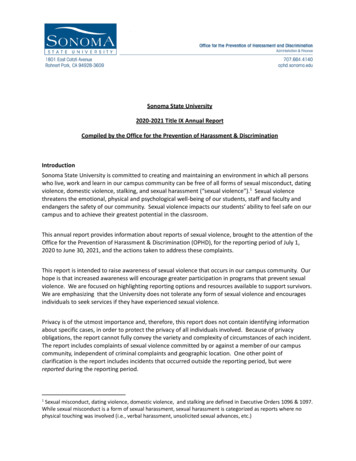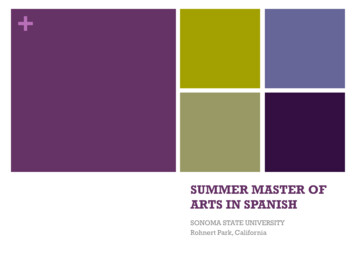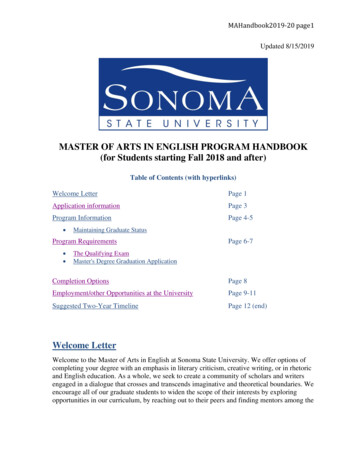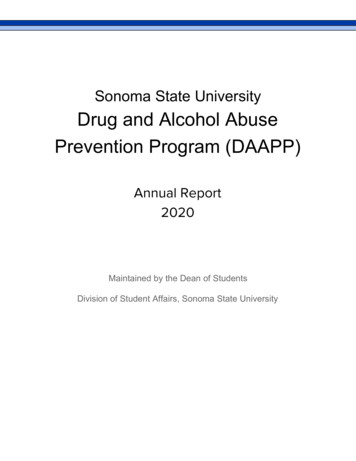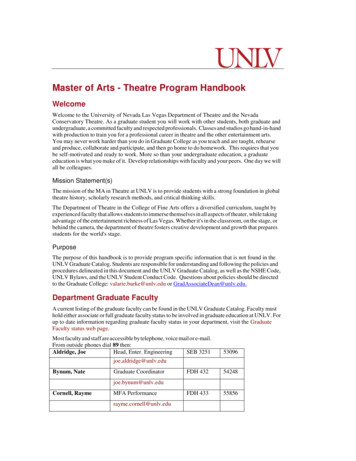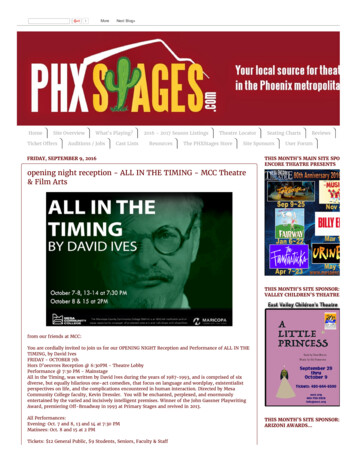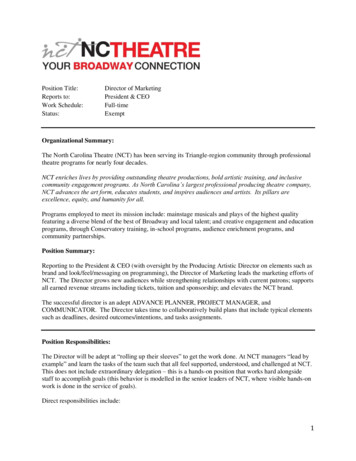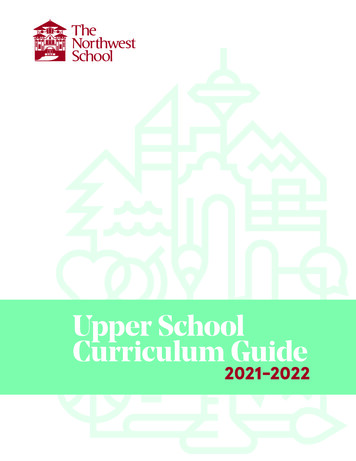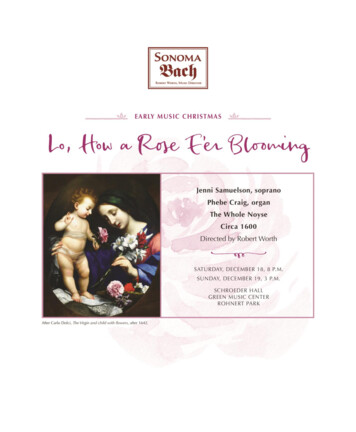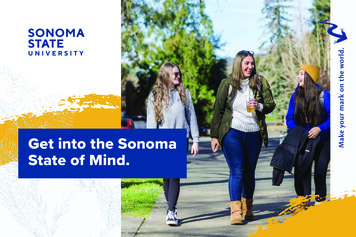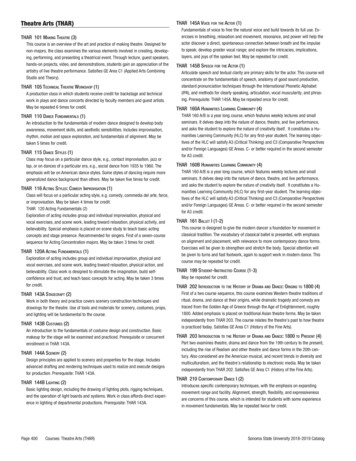
Transcription
Theatre Arts (THAR)THAR 101 Making Theatre (3)This course is an overview of the art and practice of making theatre. Designed fornon-majors, the class examines the various elements involved in creating, developing, performing, and presenting a theatrical event. Through lecture, guest speakers,hands-on projects, video, and demonstrations, students gain an appreciation of theartistry of live theatre performance. Satisfies GE Area C1 (Applied Arts CombiningStudio and Theory).THAR 105 Technical Theatre Workshop (1)A production class in which students receive credit for backstage and technicalwork in plays and dance concerts directed by faculty members and guest artists.May be repeated 6 times for credit.THAR 110 Dance Fundamentals (1)An introduction to the fundamentals of modern dance designed to develop bodyawareness, movement skills, and aesthetic sensibilities. Includes improvisation,rhythm, motion and space exploration, and fundamentals of alignment. May betaken 5 times for credit.THAR 115 Dance Styles (1)Class may focus on a particular dance style, e.g., contact improvisation, jazz ortap, or on dances of a particular era, e.g., social dance from 1935 to 1960. Theemphasis will be on American dance styles. Some styles of dancing require moregeneralized dance background than others. May be taken five times for credit.THAR 116 Acting Styles: Comedy Improvisation (1)Class will focus on a particular acting style, e.g. comedy, commedia del arte, farce,or improvisation. May be taken 4 times for credit.THAR 120 Acting Fundamentals (2)Exploration of acting includes group and individual improvisation, physical andvocal exercises, and scene work, leading toward relaxation, physical activity, andbelievability. Special emphasis is placed on scene study to teach basic actingconcepts and stage presence. Recommended for singers. First of a seven-coursesequence for Acting Concentration majors. May be taken 3 times for credit.THAR 120A Acting Fundamentals (1)Exploration of acting includes group and individual improvisation, physical andvocal exercises, and scene work, leading toward relaxation, physical action, andbelievability. Class work is designed to stimulate the imagination, build selfconfidence and trust, and teach basic concepts for acting. May be taken 3 timesfor credit.THAR 143A Stagecraft (2)Work in both theory and practice covers scenery construction techniques anddrawings for the theatre. Use of tools and materials for scenery, costumes, props,and lighting will be fundamental to the course.THAR 143B Costumes (2)An introduction to the fundamentals of costume design and construction. Basicmakeup for the stage will be examined and practiced. Prerequisite or concurrentenrollment in THAR 143A.THAR 144A Scenery (2)Design principles are applied to scenery and properties for the stage. Includesadvanced drafting and rendering techniques used to realize and execute designsfor production. Prerequisite: THAR 143A.THAR 144B Lighting (2)Basic lighting design, including the drawing of lighting plots, rigging techniques,and the operation of light boards and systems. Work in class affords direct experience in lighting of departmental productions. Prerequisite: THAR 143A.Page 400Courses: Theatre Arts (THAR)THAR 145A Voice for the Actor (1)Fundamentals of voice to free the natural voice and build towards its full use. Exercises in breathing, relaxation and movement, resonance, and power will help theactor discover a direct, spontaneous connection between breath and the impulseto speak; develop greater vocal range; and explore the intricacies, implications,layers, and joys of the spoken text. May be repeated for credit.THAR 145B Speech for the Actor (1)Articulate speech and textual clarity are primary skills for the actor. This course willconcentrate on the fundamentals of speech, anatomy of good sound production,standard pronunciation techniques through the International Phonetic Alphabet(IPA), and methods for clearly speaking, articulation, vocal muscularity, and phrasing. Prerequisite: THAR 145A. May be repeated once for credit.THAR 160A Humanities Learning Community (4)THAR 160 A/B is a year long course, which features weekly lectures and smallseminars. It delves deep into the nature of dance, theatre, and live performance,and asks the student to explore the nature of creativity itself. It constitutes a Humanities Learning Community (HLC) for any first-year student. The learning objectives of the HLC will satisfy A3 (Critical Thinking) and C3 (Comparative Perspectivesand/or Foreign Languages) GE Areas. C- or better required in the second semesterfor A3 credit.THAR 160B Humanities Learning Community (4)THAR 160 A/B is a year long course, which features weekly lectures and smallseminars. It delves deep into the nature of dance, theatre, and live performance,and asks the student to explore the nature of creativity itself. It constitutes a Humanities Learning Community (HLC) for any first-year student. The learning objectives of the HLC will satisfy A3 (Critical Thinking) and C3 (Comparative Perspectivesand/or Foreign Languages) GE Areas. C- or better required in the second semesterfor A3 credit.THAR 161 Ballet I (1-2)This course is designed to give the modern dancer a foundation for movement inclassical tradition. The vocabulary of classical ballet is presented, with emphasison alignment and placement, with relevance to more contemporary dance forms.Exercises will be given to strengthen and stretch the body. Special attention willbe given to turns and fast footwork, again to support work in modern dance. Thiscourse may be repeated for credit.THAR 199 Student-Instructed Course (1-3)May be repeated for credit.THAR 202 Introduction to the History of Drama and Dance: Origins to 1800 (4)First of a two course sequence, this course examines Western theatre traditions ofritual, drama, and dance at their origins, while dramatic tragedy and comedy aretraced from the Golden Age of Greece through the Age of Enlightenment, roughly1800. Added emphasis is placed on traditional Asian theatre forms. May be takenindependently from THAR 203. The course relates the theatre’s past to how theatreis practiced today. Satisfies GE Area C1 (History of the Fine Arts).THAR 203 Introduction to the History of Drama and Dance: 1800 to Present (4)Part two examines theatre, drama and dance from the 19th century to the present,including the rise of Realism and other theatre and dance forms in the 20th century. Also considered are the American musical, and recent trends in diversity andmulticulturalism, and the theatre’s relationship to electronic media. May be takenindependently from THAR 202. Satisfies GE Area C1 (History of the Fine Arts).THAR 210 Contemporary Dance I (2)Introduces specific contemporary techniques, with the emphasis on expandingmovement range and facility. Alignment, strength, flexibility, and expressivenessare concerns of this course, which is intended for students with some experiencein movement fundamentals. May be repeated twice for credit.Sonoma State University 2018-2019 Catalog
THAR 211 Contemporary Dance II (2)Continuation of THAR 210. Prerequisite: THAR 210. May be repeated twice forcredit.THAR 212 Contemporary Dance Level III (2)Continuation of THAR 211. Prerequisite THAR 210. May be repeated twice forcredit.THAR 213 Contemporary Dance Level IV (2)Continuation of THAR 212. Prerequisite: THAR 210. May be repeated twice forcredit.THAR 220A Acting: Text and Scene Study (2)Text analysis and scoring, rehearsals, and in-class presentation of scenes drawnfrom realistic dramatic literature. Work with emotional memory and characterization. Core course for Acting Concentration majors. May be taken two times forcredit. Prerequisites: THAR 120 or equivalent or consent of Director of the ActingProgram. Open to THAR sophomores, juniors and seniors.THAR 220B Acting: Characterization (2)The focus of this course is on aiding the actor in developing a process for creatingbelievable dramatic characters, and bringing them truthfully to life in theatricalcontext. Study of life models support presentations of rehearsed scenes, which arethen critiqued and developed in class. Scenes are normally drawn from realisticdramatic literature. This course is the third in the Acting Concentration sequence,and is a core course for acting majors. May be taken two times for credit. Prerequisites: THAR 120 and 220A or equivalent and consent of instructor.THAR 230 Stage Management (2)The functions of the stage manager from audition to final performance areexamined. Students are trained to organize rehearsals, record actors’ movements,create prompt books, and to manage a performance. Students serve as stagemanagers for Performing Arts productions. Prerequisites: THAR 144A and B.THAR 231 Stage Management (1)Stage Management Practicum. Students serve as stage managers for PerformingArts productions. Prerequisite: THAR 230 (or co-requisite) or consent of instructor.THAR 240 Choreography I (2)Fundamentals of choreography through a problem-solving approach. Studiesdeal with aspects of time, space, dynamics and movement, with an emphasis onperceptions of meaning, that is, on “seeing” dancing as well as “making” dancing.May be taken two times for credit. Prerequisite: THAR 210 or consent of instructor.THAR 244 Scene Painting (2)Study and practice of the basics of layout and painting of scenery, from renderingto full scale. Students assist in painting scenery used in Theatre and Dance productions. Includes instruction on handling toxic materials safely and on protectingthe environment. Prerequisites: THAR 143A and B, 144A and B.THAR 261 Ballet II (1-2)Continuation of study of classical ballet. Traditional barre with allegro and adagiocenter work. Western classical dance skills emphasizing strength, alignment, flexibility, and musicality as a support for contemporary dance styles. May be taken 4times for credit. Prerequisite: THAR 161 or consent of instructor.THAR 273 Literature and Performance: Critical and Creative Readings (4)This course explores the relationship between literature and performance, readingand rendition, the interaction between the literary skills of close reading, embodiedreading, and possible productions of these readings on the page, stage or screen.Satisfies GE Area C2. Only one course numbered 273 in the Arts & Humanities willbe considered for credit. Prerequisite: completion of GE Category A2 (Engl 101 orENGL 100B) required.Sonoma State University 2018-2019 CatalogTHAR 275 Contemporary Plays and Playwrights (3)This class is an exciting and dynamic way to explore contemporary American playwriting and its impact of on the current American theatre scene. It offers some ofthe finest writing that is occurring in this country today. Students will discover theatrical trends of our own era, and how these trends relate to contemporary politics.May be repeated for credit.THAR 295 Community Involvement Program (1-4)Credit for participation in internships arranged through individual contact with aTheatre Arts or Dance faculty member.THAR 300 Theatre in Action (3)Required of all Theatre Arts majors. An investigation of technique, form, andcontent in drama and dance performances. Attendance at oral discussion and written critiques of 7-8 departmental, local, and/or Bay Area productions will developarticulate understanding of contemporary performance and its relation to theatrehistory, the arts, society, and culture. Activities fee payable at time of registration. Satisfies upper division GE Area C1 (History of the Fine Arts). For juniors andseniors only. (Also available as periodic trips to New York.) May be taken 2 timesfor credit.THAR 301 Dance Ensemble (1-3)A process-and-product class in which students receive credit for major participation in areas of dance, choreography, or technical work (costumes, light, decor) forpresentation in public performance. Dances may be choreographed and directedby faculty, guest artists, or students. May be repeated 6 times for credit. Prerequisite: THAR 240 or consent of instructor.THAR 302 Drama Ensemble Workshop (1-3)A production class in which students receive credit for major participation as apartner in plays directed by faculty members and guest artists. Play titles, performance venues, styles, and production approaches vary from semester to semester.May be repeated 6 times for credit. By audition or consent of instructor.THAR 303 Technical Theatre Workshop (1-3)A production class in which students receive credit for design, backstage, andtechnical work in plays directed by faculty members and quest artists. May berepeated 6 times for credit. By audition or consent of instructor.THAR 304 Production Dramaturgy (1-3)This course teaches practical, hands-on rehearsal dramaturgy as practiced in theprofessional theatre. Students are assigned to work closely on a production in thedepartment season, and implement story analysis, in-depth research, and information design to help shape the production. Key elements of dramaturgical workinclude concept work with the director, research for cast, program notes, outreachtalks, study guides, and other possible outcomes based on the production’s needs.May be repeated for credit.THAR 310A Intermediate Dance Block (2-5)The Dance Block integrates the study of contemporary dance technique with thestudy of improvisation and anatomy for dancers. The safe and intelligent use ofthe body, the development of technical and improvisational skills, and artistry areemphasized. Prerequisites: THAR 210, and consent of instructor. May be repeatedfor credit.THAR 310B Intermediate Dance Block (2-5)Continuation of THAR 310A. Prerequisites: THAR 310A and consent of instructor.May be repeated for credit.Courses: Theatre Arts (THAR)Page 401
THAR 311 Actor / Dancer Collaboration I: Core Technique & Practice (1)This course introduces somatic-based movement emphasizing functionality,efficiency and body awareness for performance. Pedagogy engages students inexperiential training methods such as Yoga, Feldenkrais, Pilates, and Body-MindCentering focusing on mindfulness, expressivity, longevity and students¿ health.Prerequisite: THAR 22B or consent of Acting or Dance Program advisors. Face-toface mode.THAR 312 Actor / Dancer Collaboration II: Movement & Improvisation (1)In this course, the student will be guided through explorations and exercises toincrease mobility, expression, imagination and collaboration. Pedagogy incorporates experiential training and skill building that includes Contact Improvisation,Conditioning, Partnering, Collaboration, and more. Prerequisite: THAR 311 orconsent of Acting or Dance Program advisors. Face-to-face mode.THAR 313 Ballroom & Social Dance (1)This course teaches American Ballroom Dancing including the Waltz, Fox Trot,Tango, and Viennese Waltz. Students will learn Mechanics, Rhythm, and Style. Amain emphasis will be on the duet partnership. No prerequisite. Face-to-face. Maybe taken once for UD Acting Concentration credit, and a second time as an elective.THAR 314 Connection, Communication, Collaboration (1)Actors and Dancers learn to work across disciplines sharing modes of learning,performance techniques to find new ways for mutual engagement. Prerequisite:THAR 311 or Acting or Dance Program Director consent. Face-to-face mode. Maybe taken once for UD Acting Concentration credit, and a second time as an elective.THAR 316 25 Elements of Comedy: Its All in the Surprise (1)Comedy is BIG business, and a lot of fun. Actors play with 25 elements of comedythrough comic scenes, action, and stage business. Prerequisite: THAR 120 orconsent of Acting Program advisors. Face-to-face mode. May be taken once for UDActing Concentration credit, and a second time as an elective.THAR 320A Shakespeare I: Verse Scansion & Paraphrase (2)A course in acting techniques for Shakespeare: scansion, paraphrase, vocalproduction, monologues and scenes. Prerequisites: THAR 120, 145A, 145B, 220A,220B, and ENG 339 or consent of Acting Program advisors. Face-to-face mode. Required for Acting Majors. May be repeated once for elective credit. Recommendedfor Hutchins and English majors.THAR 320B Shakespeare II: Scene Study (2)This advanced course builds on Shakespearean acting techniques, deepeninganalysis of text and introducing rhetorical devices and use of irony. Featuresadvanced scene study of prose scenes and scenes where both verse and proseare employed. Prerequisites: ENG 339 and 320A or consent of Acting Programadvisors. Face-to-face mode. It will be offered once every 4 semesters. Mostimportantly, separating out Block content into discrete courses with individualcourse titles and descriptions will open content to more students and increaseacting course enrollments overall, for majors, minors and other qualified studentsacross campus.THAR 320C Physical Theatre Workshop (2)Actors learn to physicalize character through movement fundamentals, stamina,and relaxation. Stage presence is addressed through exploration of scenes thatdemand a dominant physical approach for their effective realization. Prerequisites:THAR 120, 145A, 145B, 220A, and 220B, or consent of Acting Program advisors.Required for UD Acting Concentration. Face-to-face mode.THAR 320D Commedia dell Arte & Masks (2)The eyes are the windows to the soul and the mask a whole open doorway. Actorsliterally look through someone else’s eyes and find physical transformation anda new way of relating to the audience. Prerequisites: 320C or consent of ActingProgram advisors. Required for Acting Concentration. Face-to-face mode.Page 402Courses: Theatre Arts (THAR)THAR 321A Intermediate Technical Block/Foundations (2)Technical concentration students participate in the foundations, script analysis, anddesign projects. Prerequisites: THAR 143A and B, THAR 144A and B, THAR 244, andconsent of instructor.THAR 321B Intermediate Technical Block (2)Technical concentration students participate in the foundations, script analysis, anddesign projects. Prerequisites: THAR 143A and B, THAR 144A and B, THAR 244,THAR 321A, and consent of instructor. May be repeated once for credit.THAR 322A Advanced Scene Study (2)Text analysis and scoring, rehearsals, and in-class preparation of scenes drawnfrom realistic dramatic literature. Work with emotional memory and characterization. Core course for Acting Concentration majors. May be taken twice for credit.Prerequisites: THAR 120B or equivalent and consent of instructor.THAR 322B Advanced Scene Study (2)Text analysis and scoring, rehearsals, and in-class preparation of scenes drawnfrom realistic dramatic literature. Work with emotional memory and characterization. Core course for Acting Concentration majors. May be taken twice for credit.Prerequisites: THAR 120, THAR 220A or 322A or equivalent, and consent ofinstructor.THAR 324 On Camera: Acting & Production (2)Acting and performing in front of the camera, although similar to theater, is distinctive in approach and technique. This course is an introduction to film and TV actingwhere acting students acquire techniques for working in front of the camera andfilm students learn to set up camera and audio equipment and work behind thecamera. The On- Camera course is intended for advanced actors to further developtechniques assimilated in the courses prerequisites of THAR 120 and 220A. Filmproduction students may enroll with permission of instructor.THAR 325 Audition for the Theatre (2)This course is designed to cover the practical aspects of auditioning for thetheatre, including 1) selecting appropriate material, e.g., classic/modern, dramatic/comic, musical/revue; 2) preparing audition pieces; 3) giving a winning audition; 4)evaluating performance for future guidance; and 5) resume and headshot needs.Prerequisite: THAR 120, or consent of instructor.THAR 326 Circus Technique (1)The course develops circus techniques for theatrical presentation teaching basiccircus skills, while providing resources for continued skill development. Prerequisites: THAR 120 or consent of Acting Program advisors. Face-to-face mode. Maybe taken once for UD Acting Concentration credit, and a second time as an elective.THAR 327 Stage Combat (1)Stage Combat introduces safe portrayal of violence onstage to create the illusion ofdanger to facilitate storytelling, character development, and given circumstances.Modes include swordplay, hand-to-hand combat, among others. No prerequisite.Face-to-face mode. May be taken once for UD Acting Concentration credit, and asecond time as an elective.THAR 328 Accents & Dialects (1)Actors create believable accents and dialects using the International PhoneticAlphabet (IPA) as a cornerstone. Students also learn how to acquire accents ontheir own. Prerequisite: THAR 145A and 145B. Face-to-face. May be taken once forUD Acting Concentration credit, and a second time as an elective.THAR 330 Musical Theatre Production (1-3)A course devoted to the study and performance of musical theatre literature.Designed for singers, actors, and others interested in musical theatre. This coursemay be repeated for credit.Sonoma State University 2018-2019 Catalog
THAR 340 Choreography II (2)Further development of choreographic skills and artistry. Includes problems ingroup choreography and relationship to fundamentals of rhythm. Prerequisite:THAR 240.THAR 343 Advanced Scene Painting (2)The basics of layout techniques and painting of full-scale scenery will be realizedby the class with hands-on painting of the SSU productions for that semester. Thiscourse includes sections on being safe with toxic materials, and how to keep theenvironment green. Prerequisites: THAR 143A, 144A and B.THAR 344A Design for the Stage (3)An advanced course examining design and rendering techniques for the stage.Students learn advanced drafting techniques. Class works as a team, with studentsassuming various design responsibilities for selected plays. Prerequisites: THAR144A and B, and consent of instructor.THAR 344B Design for the Stage (3)Continuation of THAR 344A. Prerequisites: THAR 144A and B, THAR 344A, andconsent of instructor.THAR 345 Choreography III (2)Further development of choreographic skills and artistry, including more extensivegroup choreography and relationship of movement to sound and music. Prerequisite: THAR 340.THAR 350 Directing Workshop (2)A workshop in directing scenes and compositions. Rehearsal and techniques, composition, blocking, characterization, rhythm, style, and script analysis are explored.Approaches of significant directors are examined. May be taken 3 times for credit.Prerequisites: all lower-division Theatre major/minor requirements, or consent ofinstructor.THAR 355 Advanced Directing Workshop (2)An advanced workshop in composition, technique, and directed scenes and oneact plays that are rehearsed, presented, and critiqued as a means of reaching afinal public performance. The course builds upon basic directing concepts andterms necessary for communication with actors and designers, while utilizingskills of research, text analysis, and staging principles. Prerequisite: THAR 350 orconsent of instructor.THAR 370A Early Plays: Evolution and Innovation (3)An examination of Western theatre from the Greeks to the Enlightenment. Playsare used as a basis for understanding how theatre reinvents itself to reflect socialand historical currents. Emphasis on how dramatic literature and history can beinterpreted and re-examined to resonate with today’s theatre. The theatre artist isviewed as a voice for humanity as well as a force for social change. Prerequisite:THAR 202 or consent of instructor.THAR 370B Modern Plays: Evolution and Innovation (3)Seminar on dramatic literature from the late 19th century to our own time. Continuation of THAR 370A. Prerequisite: THAR 203 or consent of instructor. May betaken out of sequence.THAR 371A History of Dance A (3)Survey of the history of Western theatrical dance from ritual roots to 19th centuryRomantic and Classical ballet. Prerequisite: THAR 202 or consent of instructor.THAR 371B History of Dance B (3)Survey of the history of theatrical dance in the 20th century, including globalinfluences on the most recent dance forms. Prerequisite: THAR 371A or consent ofinstructor.Sonoma State University 2018-2019 CatalogTHAR 373 Dances of the World (4)Examination of dance as cultural expression in diverse global dance forms. Thiscourse focuses on ways in which social, ritual, and theater dance styles create andreflect cultural identity, define tradition and embrace innovation, and intersect in aglobal world. Satisfies upper-division GE Area C3.THAR 374 Theatre of the World (4)This course is an exploration of theatre traditions from around the world. Theatre isexamined as the expression of specific cultures. Students learn how theatre practice influences theatre-making in both Western and Eastern Cultures. This courseis required for General Theatre Degree majors and also satisfies upper-division GEArea C3.THAR 375 Race, Gender, and Performance (3)This course explores how contemporary theater artists construct cultural identity,with a particular focus on gender, sexuality, race, and ethnicity. Students engagein both written analysis and performance work. Topics covered include culturallyspecific modes of ritual, belief, and performance; representation of mixed-raceidentities; and oppressive and resistant strategies in casting and production.Cross-listed as WGS 360.THAR 376 Playwriting I (3)An introduction to the art and craft of writing for the stage, for writers of diverselevels of experience. Focuses in particular on the development of character, andexplores the virtues of both imaginative freedom (the first draft) and structure (therewrite). Includes in-class writing and performance improvisations, as well as studyof plays by contemporary writers. Students create original short plays (ten-minuteor one-act) and have selections of their work performed for an audience at the endof the term.THAR 377 Playwriting II (3)Stage writing for more experienced playwrights. Students will experiment withlengthier forms and new methods for first drafts. Work is performed in an end-ofterm festival. Prerequisite: THAR 376 or permission or instructor.THAR 378 Dramaturgy and Story Analysis (3)This course explores how theater artists use text analysis to shape real-worldproduction and performance work, and in so doing model the discipline andprofessional of dramaturgy for future theater professionals, teachers, and literarycritics. Using methods drawn from the ancient Greeks (Aristotle) to contemporarycinematic story theory, students learn to determine the fundamental elements ofdramatic storytelling, otherwise known as the dramaturgical essence of the play.Students read theoretical texts and read plays as case studies, and practice theirown analysis through formal papers.THAR 379 Research Practice for Theatre and Dance (3)This course teaches professional research methodology as a means to artistryin the creation of dance and theatre, with applications to performance, design,criticism, history, and dramaturgy. Research avenues include creative and biographical material on key artists, historical and cultural context, locating imagery(print, digital, multimedia), sound/music sourcing, and materials specific to uniqueproduction needs. The course addresses best practices in information competenceand focuses on research as an art as much as a pragmatic skill. May be takentwice for credit.THAR 380 Research (3)Development of research skills. May be used in practical application to programsfor theatre arts productions. Students are encouraged to investigate topics ofpersonal interest. The final research project may consist of an exploration of aparticular era or phenomenon, or may be groundwork for a major creative project.Prerequisites: THAR 202 or 203, THAR 300, and THAR 370; or by contract with aninstructor, specifying course expectations, work to be completed, regular scheduleof contract hours, and assessment criteria. May be taken 3 times for credit.Courses: Theatre Arts (THAR)Page 403
THAR 395 Community Involvement Program (1-4)Please see appropriate concentration advisor.THAR 400 Theatre of Today (1)A career preparation course in topics vital to the emerging artist such as careerpreparation guidance, resume writing, graduate school application, professionalinternships, and community theatre options. Professional guest speakers augmentthe regular faculty.THAR 401 Senior Project Ensemble Workshop (3)An upper-division Theatre Arts student may petition the Theatre Arts faculty for permission to do a Senior Project. Such a project is the culmination of the student’swork, and may be an original work, a performance project, a research paper,a teaching project, or take some other form which represents and reflects thestudent’s interests and accomplishments. The privilege of doing a Senior Project isawarded only to a student deemed exceptional by the department faculty. Studentswho participate in another student’s Senior Project may enroll in Dance or DramaEnsemble to receive credit. Prerequisites: senior-level standing and consent ofdepartment faculty.THAR 410A Advanced Dance Block (2-5)A continuation of the work begun in 310A and B, with the focus on increasingtechnical and improvisational skill, and more refined perception of the structureand meaning of movement. Prerequisites: THAR 310A and 310B and consent ofinstructor. May be repeated for credit.THAR 410B Advanced Dance Block (1-5)A continuation of 410A. Prerequisites: THAR 410A and consent of instructor.THAR 420A Approaches to Anti-Realism (2)Actors explore Expressionism, Absurdism, Surrealism, Dada, writers such asBrecht, Beckett whose theatre is beyond the boundaries of psychological realism.Prerequisites: THAR 120, 145A, 145B, 220A, and 220B, or Acting Program Directorconsent. Face-to-face mode. Required for UD Acting Concentration credit, and as
artistry of live theatre performance. Satisfies GE Area C1 (Applied Arts Combining Studio and Theory). tHAr 105 teCHniCAL tHeAtre WorkSHop (1) A production class in which students receive credit for backstage and technical work in plays and dance concerts directed by faculty members and guest artists. May be repeated 6 times for credit.
